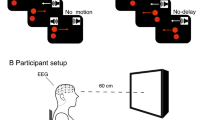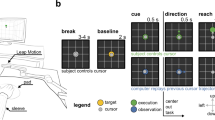Abstract
The aim of the present study was to assess changes in EEG coherence and phase locking between fronto-parietal areas, including the frontal and parietal motor areas, during early audio- and visuo-motor learning of continuous tracking movements. Subjects learned to turn a steering-wheel according to a given trajectory in order to minimise the discrepancy between a changing foreground stimulus (controllable by the subjects) and a constant background stimulus (uncontrollable) for both the auditory and the visual modality. In the auditory condition, we uncovered a learning-related increase in inter-hemispheric phase locking between inferior parietal regions, suggesting that coupling between areas involved in audiomotor integration is augmented during early learning stages. Intra-hemispheric phase locking between motor and superior parietal areas increased in the left hemisphere as learning progressed, indicative of integrative processes of spatial information and movement execution. Further tests show a significant correlation of intra-hemispheric phase locking between the motor and the parietal area bilaterally and movement performance in the visual condition. These results suggest that the motor-parietal network is operative in the auditory and in the visual condition. This study confirms that a complex fronto-parietal network subserves learning of a new movement that requires sensorimotor transformation and demonstrates the importance of interregional coupling as a neural correlate for successful acquisition and implementation of externally guided behaviour.






Similar content being viewed by others
References
Andres FG, Gerloff C (1999) Coherence of sequential movements and motor learning. J Clin Neurophysiol 16:520–527
Andres FG, Mima T, Schulman AE, Dichgans J, Hallett M, Gerloff C (1999) Functional coupling of human cortical sensorimotor areas during bimanual skill acquisition. Brain 122(Pt 5):855–870
Annett M (1970) A classification of hand preference by association analysis. Br J Psychol 61:303–321
Annett M (1992) Five tests of hand skill. Cortex 28:583–600
Baumann S, Koeneke S, Meyer M, Lutz K, Jäncke L (2006) A network for sensory-motor integration: what happens in the auditory cortex during piano playing without acoustic feedback? Ann NY Acad Sci 1060:186–188
Chambers CD, Stokes MG, Mattingley JB (2004) Modality-specific control of strategic spatial attention in parietal cortex. Neuron 44:925–930
Classen J, Gerloff C, Honda M, Hallett M (1998) Integrative visuomotor behavior is associated with interregionally coherent oscillations in the human brain. J Neurophysiol 79:1567–1573
Fink GR, Frackowiak RS, Pietrzyk U, Passingham RE (1997) Multiple nonprimary motor areas in the human cortex. J Neurophysiol 77:2164–2174
Floyer-Lea A, Matthews PM (2004) Changing brain networks for visuomotor control with increased movement automaticity. J Neurophysiol 92:2405–2412
Frutiger SA, Strother SC, Anderson JR, Sidtis JJ, Arnold JB, Rottenberg DA (2000) Multivariate predictive relationship between kinematic and functional activation patterns in a PET study of visuomotor learning. Neuroimage 12:515–527
Gaab N, Gaser C, Zaehle T, Jancke L, Schlaug G (2003) Functional anatomy of pitch memory—an fMRI study with sparse temporal sampling. Neuroimage 19:1417–1426
Gerloff C, Andres FG (2002) Bimanual coordination and interhemispheric interaction. Acta Psychol (Amst) 110:161–186
Gerloff C, Richard J, Hadley J, Schulman AE, Honda M, Hallett M (1998) Functional coupling and regional activation of human cortical motor areas during simple, internally paced and externally paced finger movements. Brain 121(Pt 8):1513–1531
Hickok G, Poeppel D (2000) Towards a functional neuroanatomy of speech perception. Trends Cogn Sci 4:131–138
Jancke L, Peters M, Schlaug G, Posse S, Steinmetz H, Muller-Gartner H (1998) Differential magnetic resonance signal change in human sensorimotor cortex to finger movements of different rate of the dominant and subdominant hand. Brain Res Cogn Brain Res 6:279–284
Jung T-P, Makeig S, Bell AJ, Sejnowski TJ (1998) Independent component analysis of electroencephalographic and event-related potential data. In: Poon P, Brugge J (eds) Auditory processing and neural modeling. Plenum press, New York, pp 189–197
Klimesch W (1999) EEG alpha and theta oscillations reflect cognitive and memory performance: a review and analysis. Brain Res Brain Res Rev 29:169–195
Laufs H, Hamandi K, Salek-Haddadi A, Kleinschmidt AK, Duncan JS, Lemieux L (2006a) Temporal lobe interictal epileptic discharges affect cerebral activity in “default mode” brain regions. Hum Brain Mapp (Epub ahead of print)
Laufs H, Holt JL, Elfont R, Krams M, Paul JS, Krakow K, et al (2006b) Where the BOLD signal goes when alpha EEG leaves. Neuroimage 31(4):1408–1418
Lehmann D, Faber PL, Gianotti LR, Kochi K, Pascual-Marqui RD (2006) Coherence and phase locking in the scalp EEG and between LORETA model sources, and microstates as putative mechanisms of brain temporo-spatial functional organization. J Physiol Paris 99:29–36
Lorch RF Jr, Myers JL (1990) Regression analyses of repeated measures data in cognitive research. J Exp Psychol Learn Mem Cogn 16:149–157
Manganotti P, Gerloff C, Toro C, Katsuta H, Sadato N, Zhuang P, et al (1998) Task-related coherence and task-related spectral power changes during sequential finger movements. Electroencephalogr Clin Neurophysiol 109:50–62
Mulert C, Jager L, Schmitt R, Bussfeld P, Pogarell O, Moller HJ, et al (2004) Integration of fMRI and simultaneous EEG: towards a comprehensive understanding of localization and time-course of brain activity in target detection. Neuroimage 22:83–94
Pascual-Marqui RD, Michel CM, Lehmann D (1994) Low resolution electromagnetic tomography: a new method for localizing electrical activity in the brain. Int J Psychophysiol 18:49–65
Pascual-Marqui RD, Esslen M, Kochi K, Lehmann D (2002) Functional imaging with low-resolution brain electromagnetic tomography (LORETA): a review. Methods Find Exp Clin Pharmacol 24(Suppl C):91–95
Pfurtscheller G, Neuper C, Krausz G (2000) Functional dissociation of lower and upper frequency mu rhythms in relation to voluntary limb movement. Clin Neurophysiol 111:1873–1879
Pineda JA (2005) The functional significance of mu rhythms: translating “seeing” and “hearing” into “doing”. Brain Res Brain Res Rev 50:57–68
Pollok B, Sudmeyer M, Gross J, Schnitzler A (2005) The oscillatory network of simple repetitive bimanual movements. Brain Res Cogn Brain Res 25:300–311
Praeg E, Herwig U, Lutz K, Jancke L (2005) The role of the right dorsal premotor cortex in visuomotor learning: a transcranial magnetic stimulation study. Neuroreport 16(15):1715–1718
Praeg E, Esslen M, Lutz K, Jancke L (2006) Neuronal modifications during visuomotor association learning assessed by electric brain tomography. Brain Topogr, 19(1–2):61–75
Roland PE, Zilles K (1996) Functions and structures of the motor cortices in humans. Curr Opin Neurobiol 6:773–781
Serrien DJ, Brown P (2002) The functional role of interhemispheric synchronization in the control of bimanual timing tasks. Exp Brain Res 147:268–272
Serrien DJ, Brown P (2003) The integration of cortical and behavioural dynamics during initial learning of a motor task. Eur J Neurosci 17:1098–1104
Serrien DJ, Cassidy MJ, Brown P (2003) The importance of the dominant hemisphere in the organization of bimanual movements. Hum Brain Mapp 18:296–305
Singer W (1993) Synchronization of cortical activity and its putative role in information processing and learning. Annu Rev Physiol 55:349–374
Singer W, Gray CM (1995) Visual feature integration and the temporal correlation hypothesis. Annu Rev Neurosci 18:555–586
Toni I, Ramnani N, Josephs O, Ashburner J, Passingham RE (2001) Learning arbitrary visuomotor associations: temporal dynamic of brain activity. Neuroimage 14(5):1048–1057
Warren JE, Wise RJ, Warren JD (2005) Sounds do-able: auditory-motor transformations and the posterior temporal plane. Trends Neurosci 28:636–643
Author information
Authors and Affiliations
Corresponding author
Rights and permissions
About this article
Cite this article
Blum, J., Lutz, K. & Jäncke, L. Coherence and phase locking of intracerebral activation during visuo- and audio-motor learning of continuous tracking movements. Exp Brain Res 182, 59–69 (2007). https://doi.org/10.1007/s00221-007-0963-7
Received:
Accepted:
Published:
Issue Date:
DOI: https://doi.org/10.1007/s00221-007-0963-7




